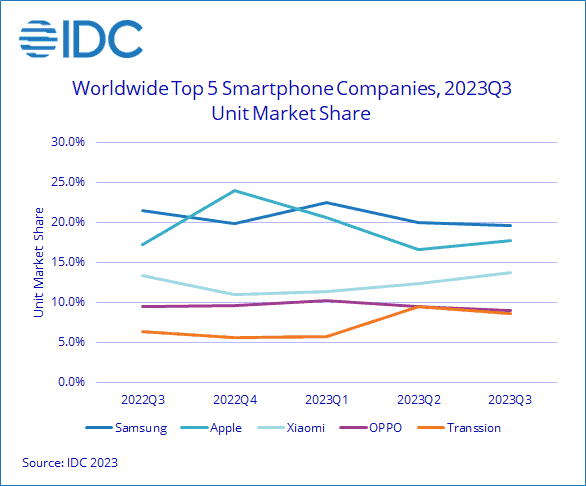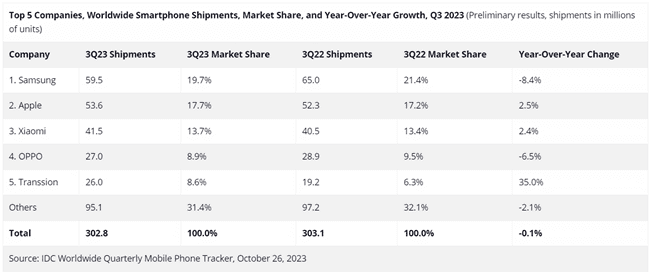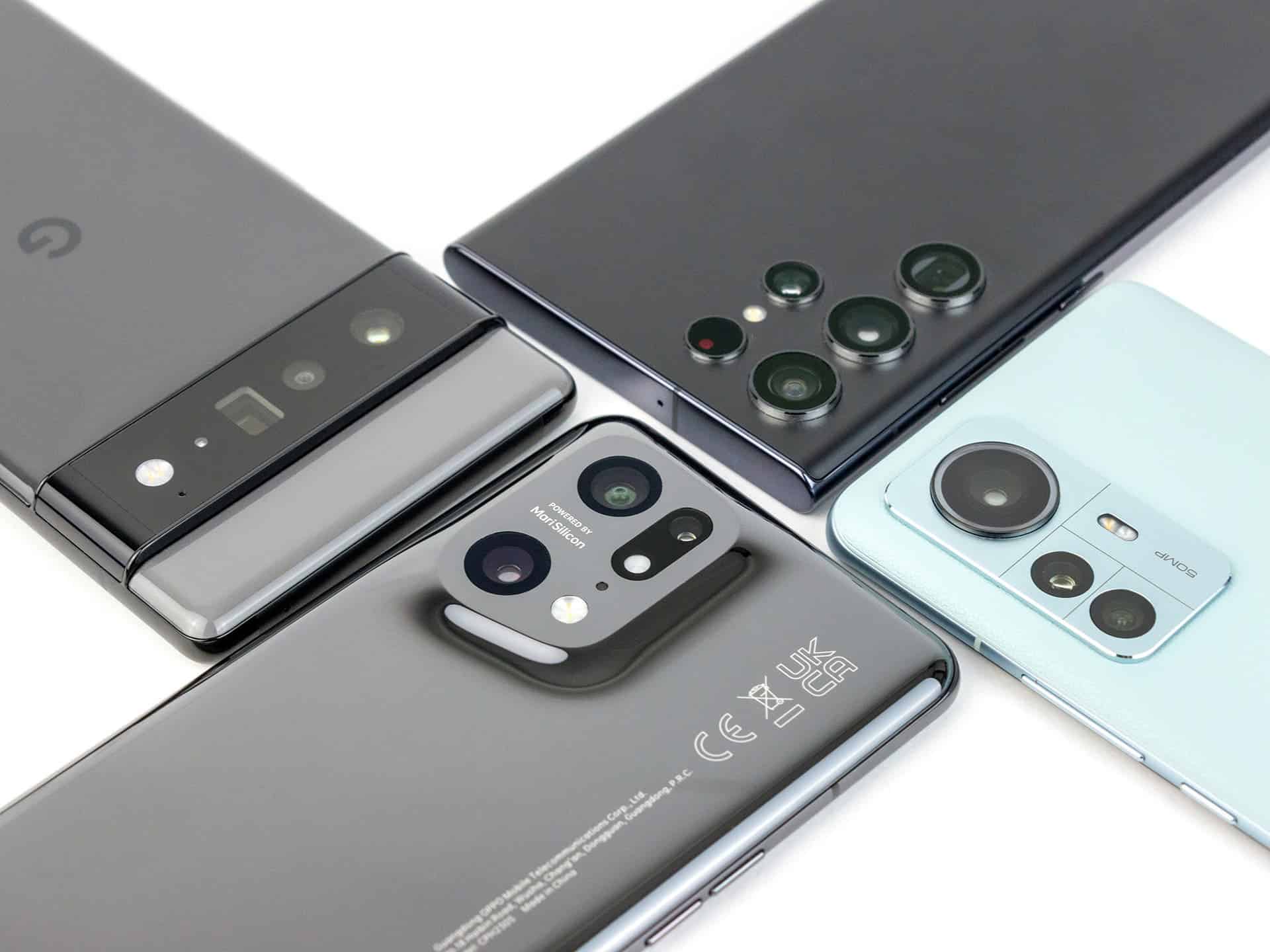The smartphone market is one of the most dynamic and competitive industries in the world. With new technologies and features emerging all the time, it is important for smartphone vendors to stay ahead of the curve in order to remain competitive.
In this article, we will analyze the key smartphone market trends in Q3 2023 and beyond. We will discuss the factors that are driving and inhibiting growth in the market, as well as the implications for smartphone vendors.
Global Smartphone Shipments declined slightly in Q3 2023

According to the International Data Corporation (IDC), worldwide smartphone shipments experienced a marginal 0.1% decline in the third quarter of 2023, totaling 302.8 million units. This decline is likely due to a number of factors, including ongoing economic uncertainties, soft demand, inflation, and geopolitical tensions.
Factors Driving Growth in the Smartphone Market
Despite the overall decline in shipments in Q3 2023, there are a number of factors that are driving growth in the smartphone market. These factors include:
- The rising demand for smartphones in emerging markets. Emerging markets such as India, Africa, and Latin America are seeing strong growth in smartphone demand. This is due to a number of factors, including the growing middle class, increasing urbanization, and the expanding availability of affordable smartphones.
- The rapid pace of technological innovation. Smartphone vendors are constantly innovating and introducing new technologies and features to their devices. This innovation is helping to drive demand for smartphones, as consumers are eager to upgrade to the latest and greatest devices.
- The growing popularity of mobile gaming and streaming. Mobile gaming and streaming are two of the most popular activities among smartphone users. This is driving demand for smartphones with powerful processors, large displays, and long battery life.
“We are seeing a strong ramp up of shipments in emerging markets by vendors like Xiaomi and Transsion,” said Nabila Popal, research director with IDC’s Mobility and Consumer Device Trackers. “While this is a good sign of approaching recovery, vendors must keep a close eye on sell-through to avoid falling into excess inventory again, as demand is still weak in many regions. Meanwhile, on the other end of the spectrum, we see Apple growing in all regions except China, where it’s facing renewed competition from Huawei as well as heightened macroeconomic uncertainties that are causing consumers who once used to rush for the latest iPhones to pause and think more carefully about their purchases.”
Factors Inhibiting Growth in the Smartphone Market
There are also a number of factors that are inhibiting growth in the smartphone market. These factors include:
- The global economic slowdown. The global economy is currently experiencing a slowdown, which is impacting consumer spending. This is likely to lead to a decline in smartphone demand in some markets.
- The increasing saturation of the smartphone market. The smartphone market is becoming increasingly saturated, with a large number of vendors competing for market share. This is making it difficult for vendors to differentiate their products and drive growth.
- The high cost of premium smartphones. Premium smartphones are becoming increasingly expensive. This is pricing out some consumers and limiting growth in the high-end segment of the market.
“The continued growth in the high-end market feels counterintuitive considering the economic challenges we are seeing across the globe,” said Anthony Scarsella, research director, Mobile Phones at IDC. “Yet the high-end continues to flourish due to generous trade-in and financing options in many developed markets. However, as consumers choose premium models, the refresh cycle will continue to extend. Superior build quality, increased storage, premium features, and longer support cycles drive buyers towards the high-end as these devices last well beyond most affordable models.”
Implications for Smartphone Vendors
The smartphone market trends in Q3 2023 and beyond have a number of implications for smartphone vendors. These implications include:
- Vendors should focus on emerging markets. Emerging markets are the key growth drivers for the smartphone market. Vendors should focus on developing and marketing smartphones that are tailored to the needs of consumers in these markets.
- Vendors should invest in technological innovation. Technological innovation is essential for remaining competitive in the smartphone market. Vendors should invest in research and development to bring new technologies and features to their devices.
- Vendors should differentiate their products. The smartphone market is becoming increasingly saturated, so it is important for vendors to differentiate their products. This can be done by focusing on unique features, design, and branding.
- Vendors should make premium smartphones more affordable. Premium smartphones are becoming increasingly expensive. Vendors should make these devices more affordable in order to reach a wider range of consumers.
The global smartphone market is facing a number of challenges, but there are still opportunities for growth. Smartphone vendors should adjust their strategies to capitalize on these opportunities, such as the rising demand for smartphones in emerging markets and the sustained growth of the high-end smartphone market.

Additional Insights and Analysis
In addition to the key trends discussed above, there are a number of other trends that are worth noting. These trends include:
- The growing popularity of foldable smartphones. Foldable smartphones are a new and emerging category of smartphones. These devices are still expensive and have a number of limitations, but they are becoming increasingly popular among consumers who are looking for a unique and innovative smartphone experience.
- The rise of 5G smartphones. 5G smartphones are becoming increasingly affordable and available. This is driving demand for 5G smartphones, as consumers want to take advantage of the faster speeds and lower latency that 5G offers.
- The increasing importance of sustainability in the smartphone market. Smartphone vendors are becoming more focused on sustainability. This is due to a number of factors, including increasing consumer demand for sustainable products and the growing environmental impact of the smartphone industry.
These trends are likely to have a significant impact on the smartphone market in the coming years.
Smartphone Vendors Should Embrace Sustainability
Sustainability is becoming increasingly important to consumers. In fact, a recent study by Nielsen found that 66% of global consumers are willing to pay more for sustainable products.
Smartphone vendors should embrace sustainability in order to meet the growing demand for sustainable products and to reduce their environmental impact. There are a number of ways that smartphone vendors can become more sustainable, such as:
- Using recycled and renewable materials in their devices.
- Designing devices that are more durable and repairable.
- Offering extended software support for their devices.
- Working with suppliers to reduce the environmental impact of the smartphone supply chain.
By embracing sustainability, smartphone vendors can differentiate themselves from their competitors and appeal to consumers who are looking for sustainable products.
Smartphone Vendors Should Invest in New Technologies
Smartphone vendors should also invest in new technologies in order to remain competitive and drive growth. Some of the key technologies that smartphone vendors should focus on include:
- Artificial intelligence (AI) and machine learning (ML). AI and ML can be used to improve the performance and functionality of smartphones in a number of ways. For example, AI can be used to improve battery life, camera performance, and security.
- Augmented reality (AR) and virtual reality (VR). AR and VR are two emerging technologies that have the potential to revolutionize the way we use smartphones. Smartphone vendors should invest in developing AR and VR applications and content for their devices.
- Next-generation displays. Smartphone displays are becoming increasingly important, as they are the primary way that users interact with their devices. Smartphone vendors should invest in developing next-generation displays with higher resolutions, refresh rates, and brightness levels.
By investing in new technologies, smartphone vendors can develop innovative and differentiated products that will appeal to consumers.

Smartphone Vendors Should Focus on the Customer Experience
In a competitive market, it is important for smartphone vendors to focus on the customer experience. This means providing customers with a positive experience from the moment they purchase a device to the moment they stop using it.
Smartphone vendors can improve the customer experience by:
- Offering excellent customer support.
- Providing timely software updates.
- Making it easy for customers to repair or replace their devices.
- Listening to customer feedback and using it to improve products and services.
By focusing on the customer experience, smartphone vendors can build loyal customers who are more likely to recommend their products to others.
Conclusion
The global smartphone market is facing a number of challenges, but there are still opportunities for growth. Smartphone vendors should adjust their strategies to capitalize on these opportunities, such as the rising demand for smartphones in emerging markets and the sustained growth of the high-end smartphone market.
In addition, smartphone vendors should embrace sustainability, invest in new technologies, and focus on the customer experience. By doing so, smartphone vendors can remain competitive and drive growth in the coming years.





